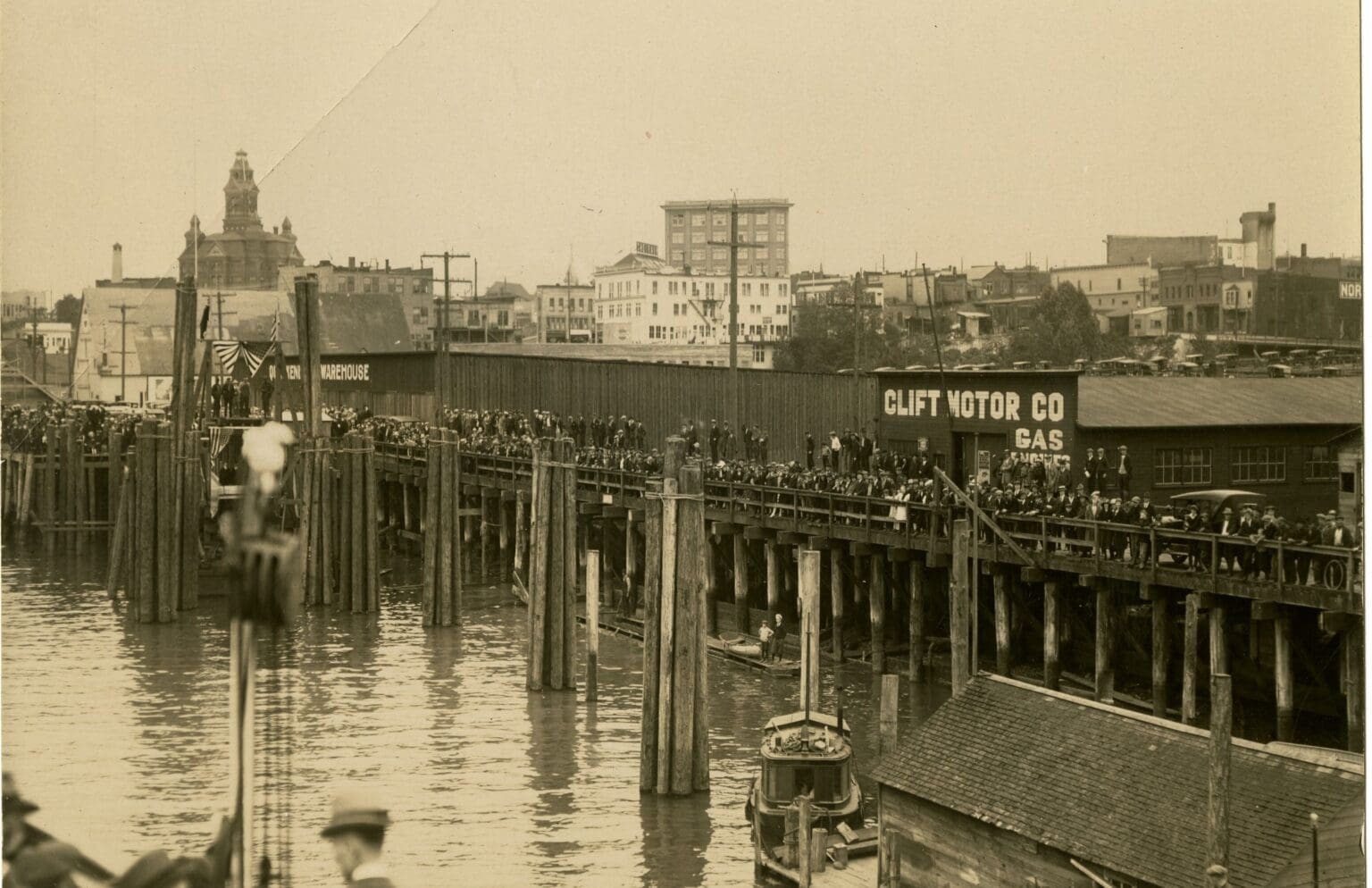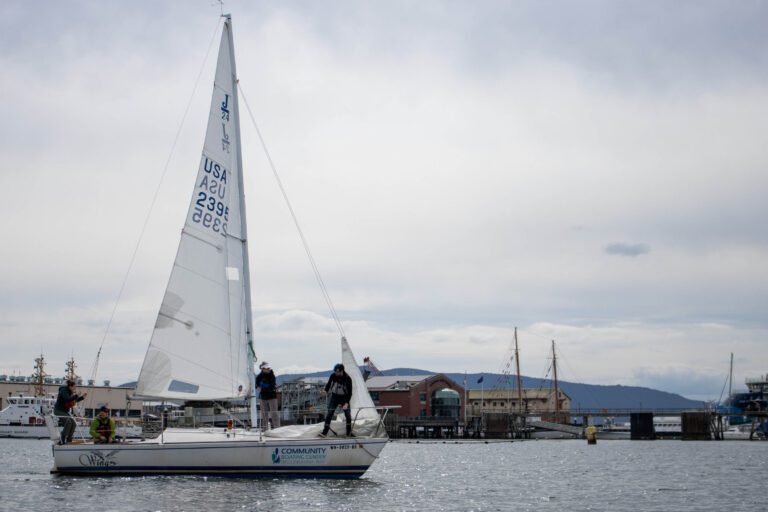Editor’s note: Working Waterfront is an occasional series that captures the past, present and future of Whatcom County’s waterfront, and highlights the people behind the industry. Today’s history story explores the figures and businesses that made Bellingham’s waterfront what it is today.
As a city founded on its ready access to the Salish Sea, Bellingham’s history has always played out on its waterfront, generally in two speeds: Gradual and gentle change while occupied by Indigenous peoples; rapid and often destructive in the two centuries since European contact.
In the millennia before contact, members of the Lummi Nation, Nooksack Indians and other Coast Salish groups paddled through the waters, gathered what they needed from the plentiful cedar groves, harvested shellfish and lived sustainably along the shores. Salmon were plentiful, filling streams, and orcas often frolicked in the bay to feast on those runs.
[ Read more: The reshaping of Bellingham Bay — from past to present ]
Toward the end of the 18th century, the first explorers arrived in Bellingham Bay, and in 1792, the waterway was named by British sea captain George Vancouver. From 1825–1846, the Hudson’s Bay Company hosted the first non-Native settlement for fur trappers — part of a sprawling trade network that extended far north and east.
But until 1850, the impacts of European and American settlers was limited.
1852: A resource-extraction economy blooms
The year 1852 saw the arrival of Henry Roeder and J.E. Peabody, seeking lumber to rebuild San Francisco, which lost nearly three-fourths of the city to a raging fire.
With the help of Lummi Nation, they established the first mill on the falls of Whatcom Creek — about where the bridge at Prospect Street runs in downtown Bellingham today. The mill was far from successful but set the stage for the next century of intense resource extraction in Whatcom County.
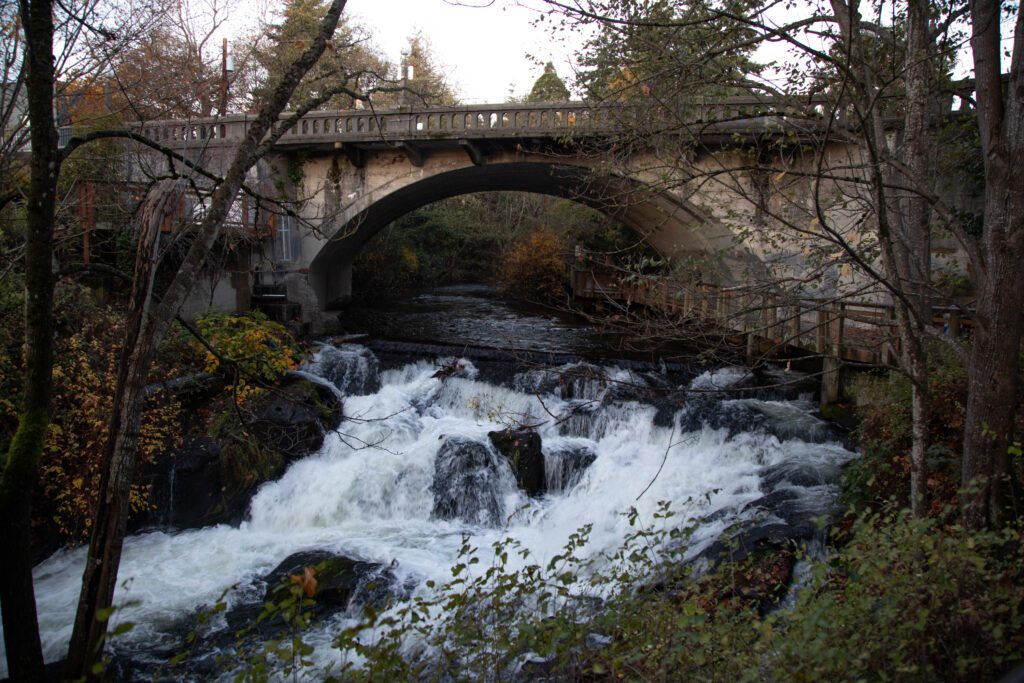
For settlers, what must have seemed like inexhaustible supplies of lumber, fish and minerals became ripe for the taking with the signing of the Treaty of Point Elliott in 1855. The pact between Indigenous people and the U.S. government sequestered native lands in the Washington Territory, enabling white immigrants to pour into Whatcom County.
By 1890, the U.S. Census estimated approximately 18,500 people lived in Whatcom County.
In the years that followed, additional lumber mills popped up. These included the Puget Sound Mill at the mouth of Padden Creek, the E.K. Wood Mill at Boulevard Park, and the Whatcom Falls Company (Loggie Mill) off Whatcom Creek.
Pacific American Fisheries (PAF) first appeared in 1899 to process local salmon, eventually establishing the largest canning operation in the world. Both industries attracted large numbers of Asian immigrant workers, leading later to a significant shift in culture — along with significant racist worker backlash — in the region. The rich salmon runs also attracted canners and fishermen from Croatia, Finland and Ireland.
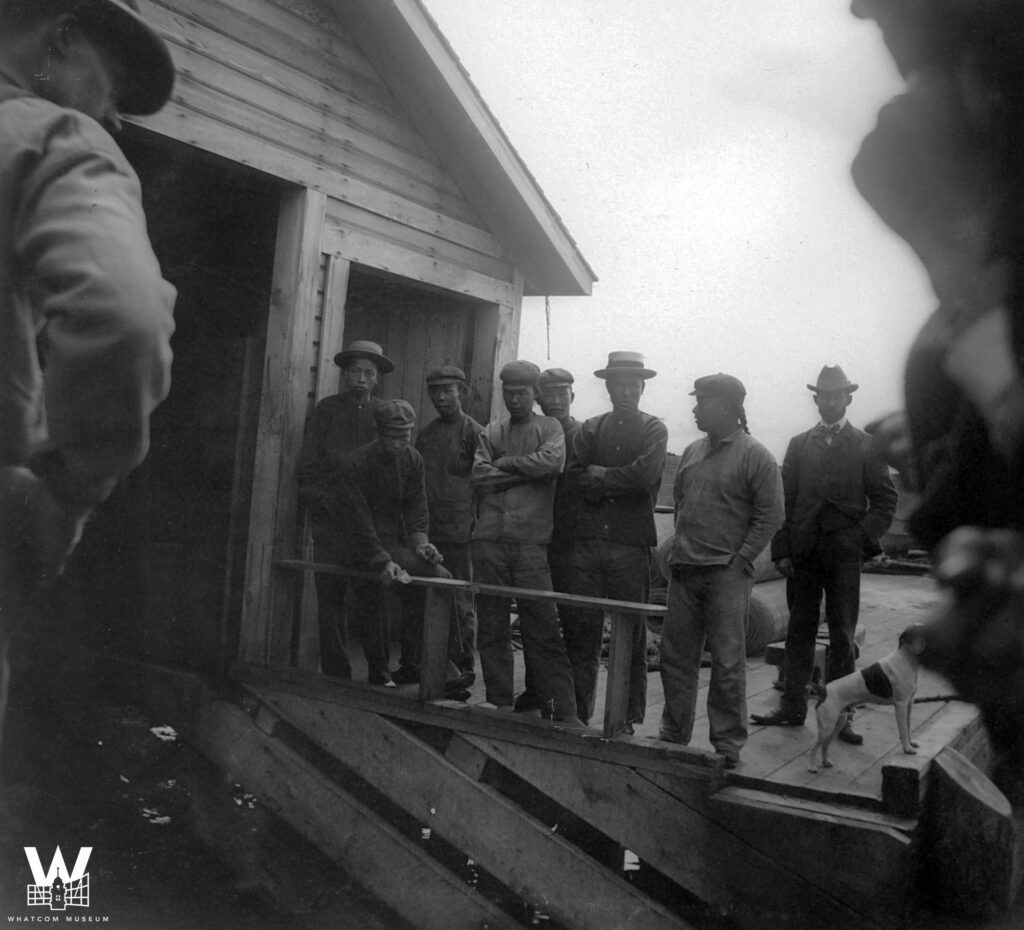
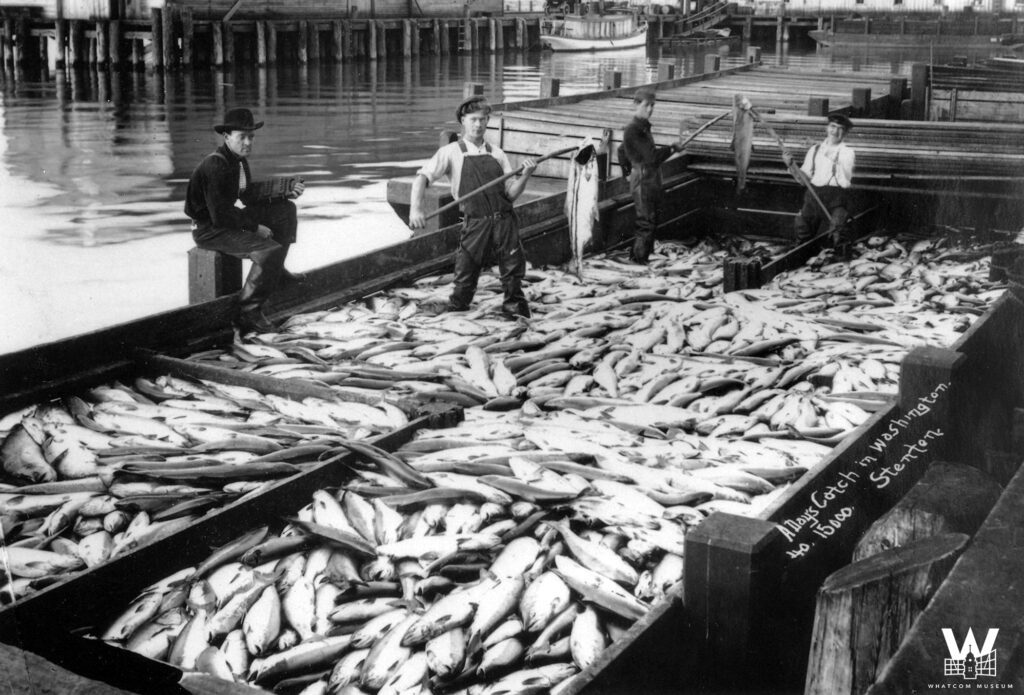
As the economy grew, so did the need to move Bellingham’s goods inland. As railroads crisscrossed America in the late 1800s, local towns vied to become the terminus for the northern transcontinental railroad — a development that could have made Bellingham a larger hub in the Northwest had that dream been realized. But shipping on the superhighway of Puget Sound remained an efficient way to distribute commodities.
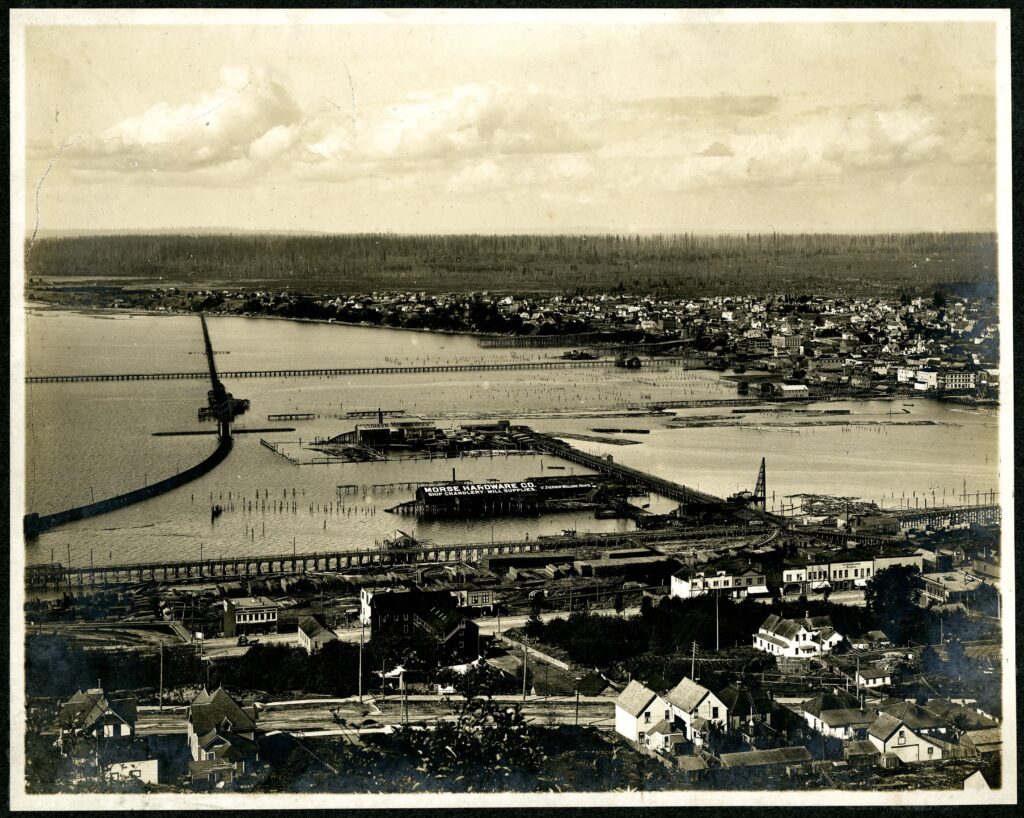
The U.S. government moved quickly, in 1890 designating federal waterways at the mouth of Whatcom Creek along the now-hidden Chinook Creek and at Squalicum Creek. Engineers devised long wharves over estuary mudflats to allow ships to dock in deeper water.
In 1904, the U.S. Army Corps of Engineers further improved access for large ships by dredging the Whatcom Waterway and cutting a deep channel to the mouth of the creek. Additional dredging operations occurred in 1906 and 1913, eventually enabling the Port of Bellingham (established in 1920) to open the first deep-ocean shipping facility in 1926. Two years later, the Squalicum Waterway was also dredged.
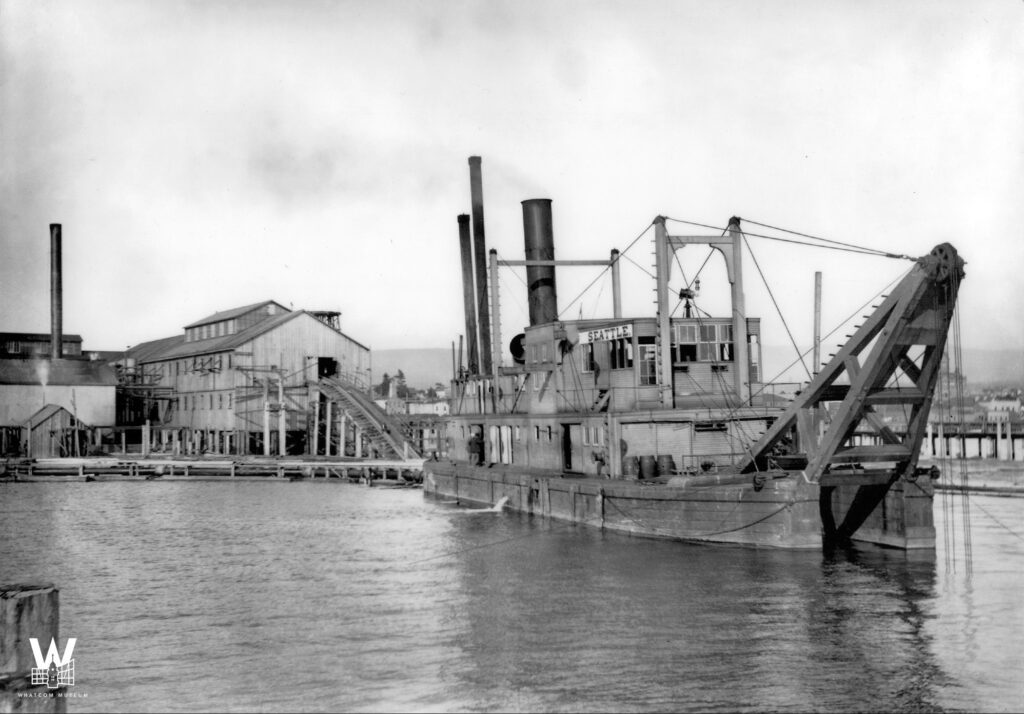
The fill that came from the bay was redistributed and reshaped the coastline to what is seen today. The first infills built up the land to Roeder Avenue and up to E Street, as evidenced by the oldest brick building in Washington state (now home to the Helen Loggie Museum of Art). Subsequent dredge fills created the C Street Wharf, the land surrounding present Squalicum Harbor, the home to Bellingham Cold Storage and most notably, portions of today’s downtown Bellingham waterfront.
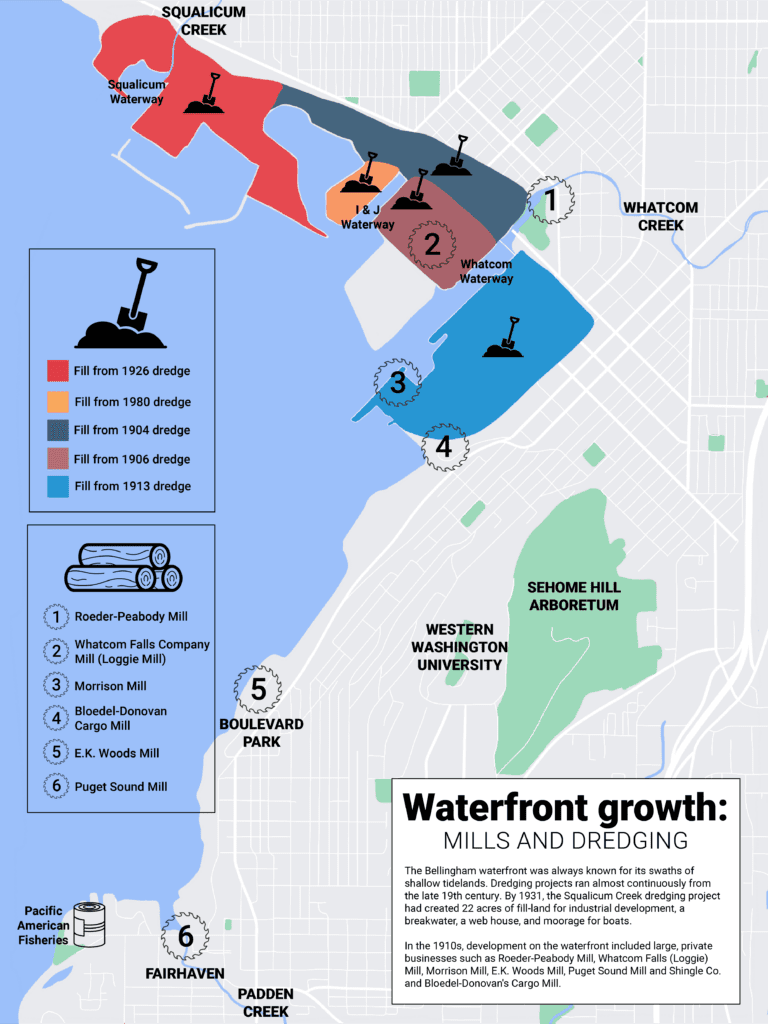
Heavy waterfront industries peaked in the 1920s, with six large lumber mills spread across the waterfront.
However, loggers had to travel deeper into the county to find the groves of old growth, which were then sent as far as Japan and Australia, or through the newly-built Panama Canal to the eastern U.S. Five-masted tall ships passed in and out of the bay regularly, dazzling the community as the logging schooners loaded up at the mills.
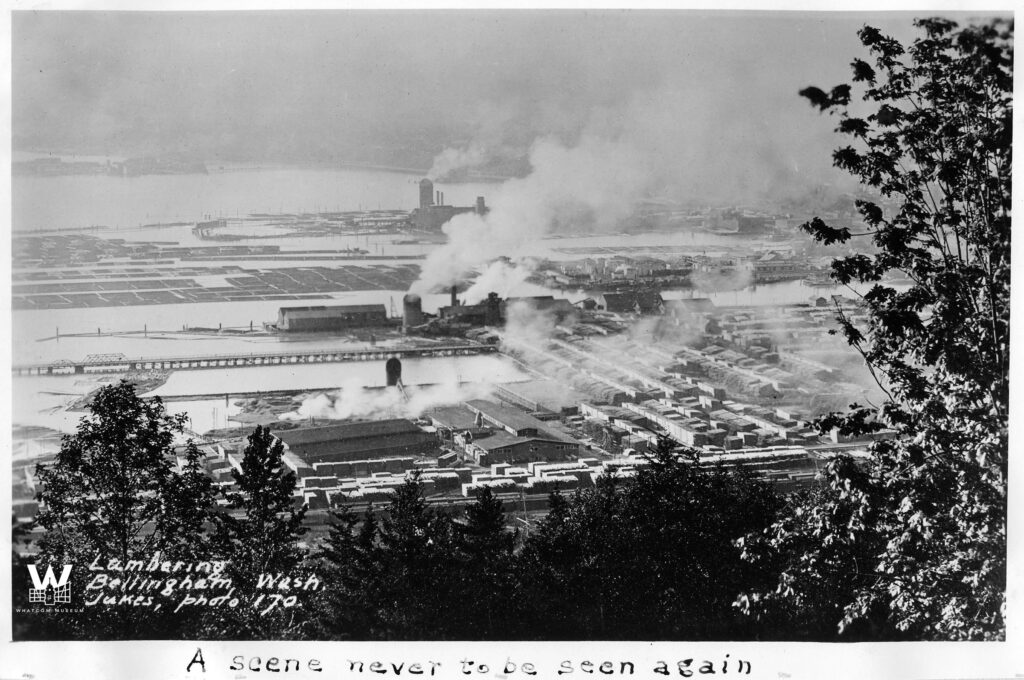
These decades on the waterfront were loud, messy and often dangerous. Steam and smog clouded the skies as waste was dumped into the bay and loud clangs reverberated into the city. Longshoremen and boom men ran along the docks, loading boats with heavy logs all hours of the day. Safety regulations were an afterthought.
Lifelong local Betty Russell recalled her grandfather’s death in the early 1930s down at the docks in a 2003 interview with the Center for Pacific Northwest Studies at Western Washington University.
“They used a single sling and the logs shifted and swung wide and pinned my grandfather to the mast of the ship, and then my dad went over and literally peeled him off the mast,” she said.
1929: Economic crisis and Great Depression
Waterfront industries took a blow from the 1929 economic crisis and the Great Depression that followed.
In the succeeding decade, all but one of the mills closed as old-growth forests dwindled and the need for lumber dried up. The Bloedel-Donovan Cargo Mill held on until 1946 while it sourced timber from the Olympic Peninsula.
Also in the 1920s, salmon runs dwindled significantly. The seemingly endless supply of fish had been worn down by the excessive use of fish traps and an increase in fishermen. In 1934, fish traps were outlawed, forcing fishermen to change tactics and limiting the number of fish they could catch.
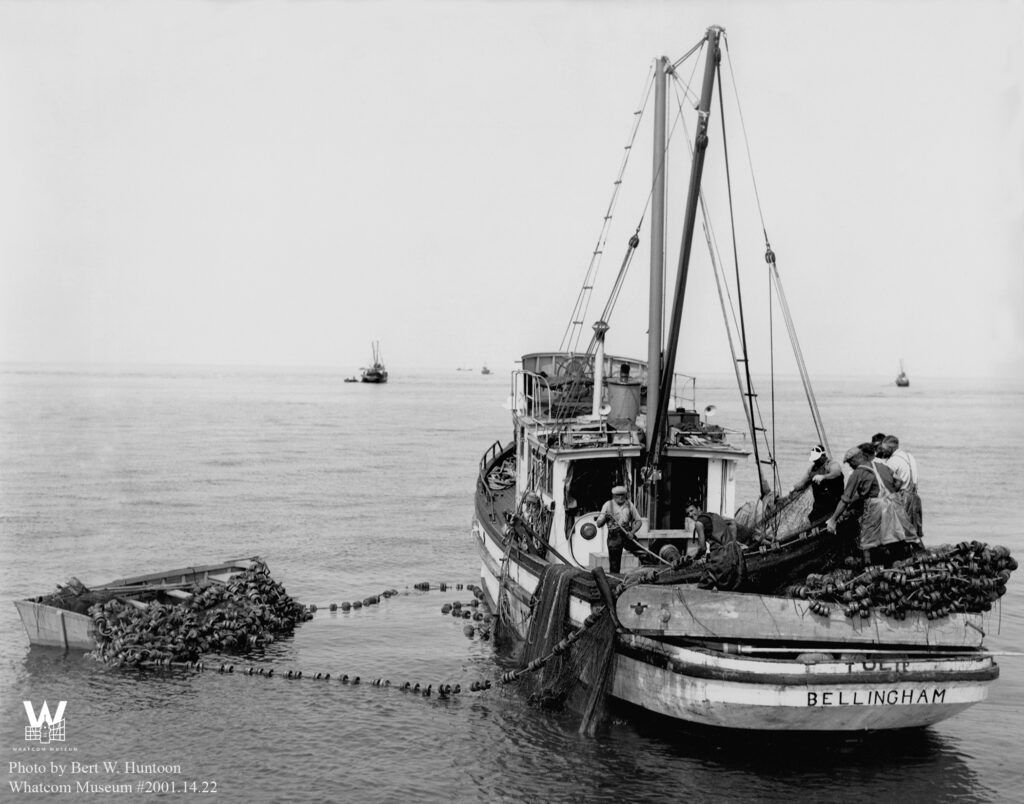
PAF continued processing fish but relied increasingly on catches from Alaska and Canada. In 1966, PAF shut its doors, marking the end of its canned salmon empire.
1940: Redevelopment begins, city joins war effort
In the 1940s, the Port of Bellingham conducted a controlled burn and razed the remnants of the lumber mills to ash.
“Bellingham said, ‘We’re going to redevelop this into a new industry,'” said Whatcom County historian Jeff Jewell.
The working waterfront began to shift away from resource extraction and found opportunities in production.
Workers struggling with the loss of stable industry jobs got a reprieve when the Squalicum Shipyard began building minesweepers and tugboats for World War II. The building process relied on large old-growth timber to construct wooden hulls to search for mines. In the Korean War, the construction of minesweepers continued, but with the exhaustion of supplies of old-growth trees, boat builders relied on a process of cross-lamination to create large beams out of smaller timber.
The lamination process soon developed into fiberglass boat fabrication. Lifeboats built for the U.S. Marines morphed into pleasure craft, with companies like Uniflite producing recreational boats starting in 1957.
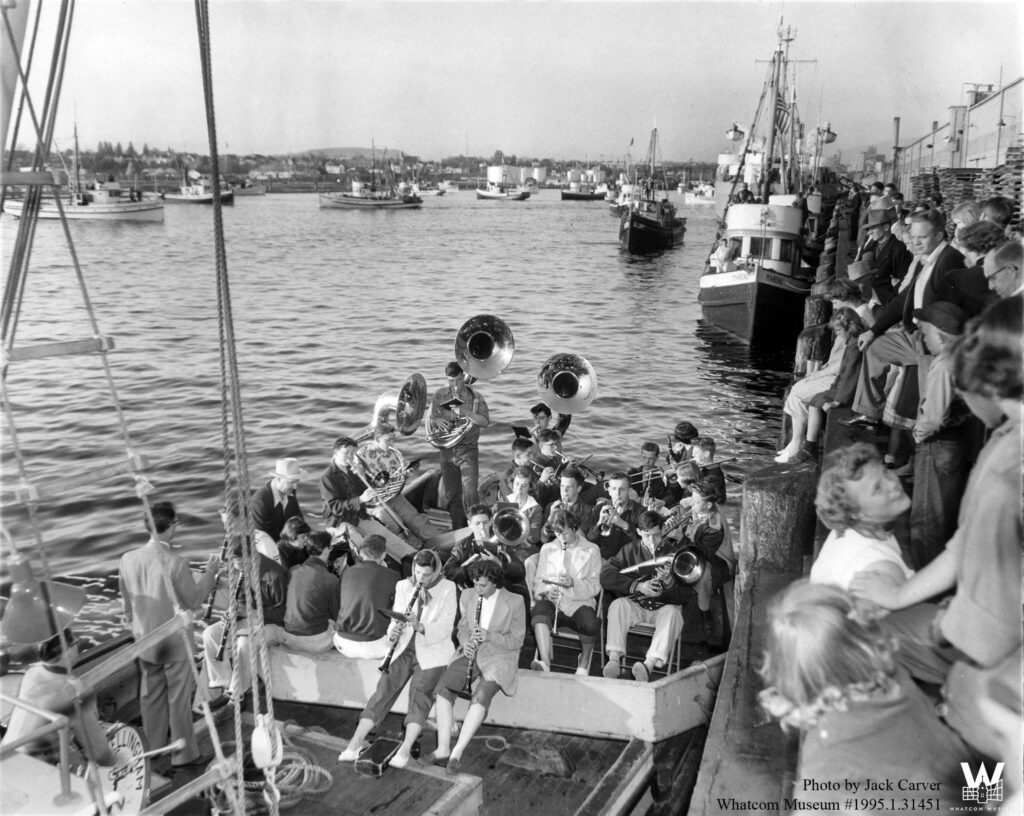
Georgia-Pacific bought the Puget Sound Pulp and Timber Company pulp mill in 1963, to manufacture toilet paper and other paper products. For decades, it served as one of the major employers of the working waterfront, providing family-wage jobs to blue-collar workers. In 1965, G-P added a Chlor-Alkali facility, notorious for dumping harmful pollutants into the bay and nearby soils.
2007: Plant operations cease, mixed-use plans begin
The plant ceased operation in 2007, taking its work abroad, and the Port of Bellingham obtained the land with plans to clean it up, redevelop it and turn it into a “mixed-use urban neighborhood” zoned for industrial, commercial and residential purposes.
Progress, initially stymied by cleanup delays and the 2008 financial crisis, has been slow.
Over those same decades, the waterfront’s longstanding staple industry, fishing, was reduced to near-extinction. The remaining non-Native fishing industry began a long, precipitous decline as stocks of Pacific wild salmon dwindled, prompting Endangered Species Act protections that continue to limit fishing for both hatchery-produced and wild fish throughout the Northwest today.
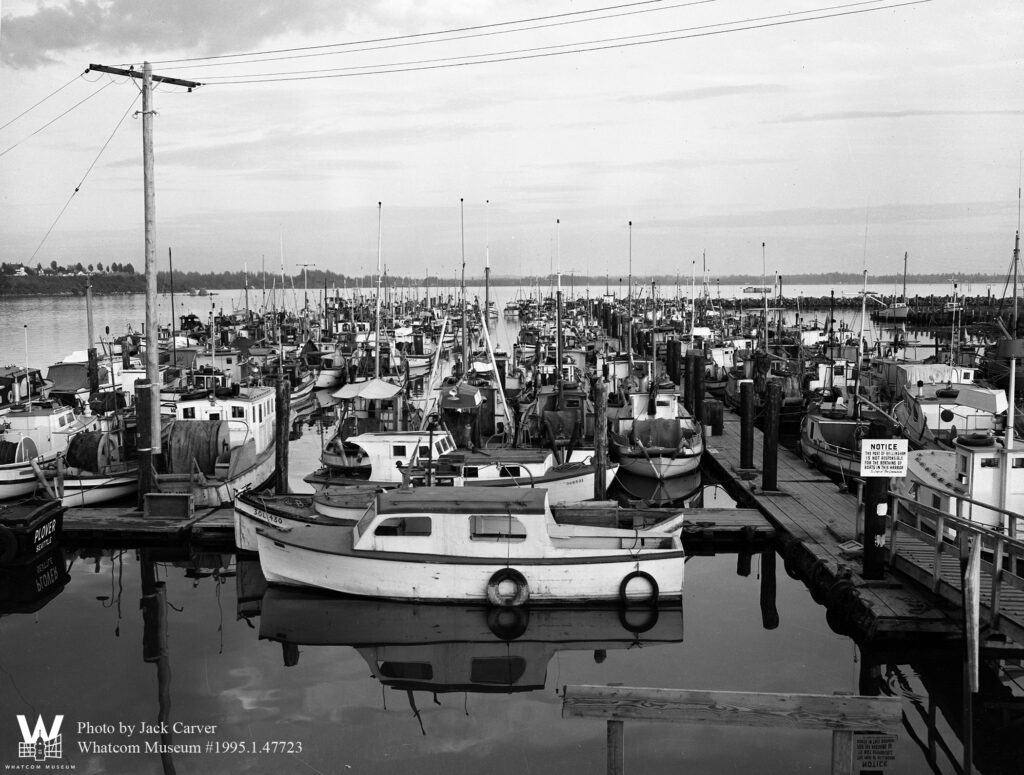
Numbers of commercial licenses shrank accordingly, especially following the the 1974 Boldt Decision, a federal court ruling that upheld Native fishing rights under the Treaty of Point Elliott.
With catches in Washington’s coastal and interior waters limited, many non-tribal fishermen went north to Alaska or abandoned their boats. The Port of Bellingham reported that the state issued more than 3,000 commercial fishing licenses in 1974; by 2004 only 155 remained.
2023: At a crossing point
Today the working waterfront operates at the cross section of recreation, residential and light industry.
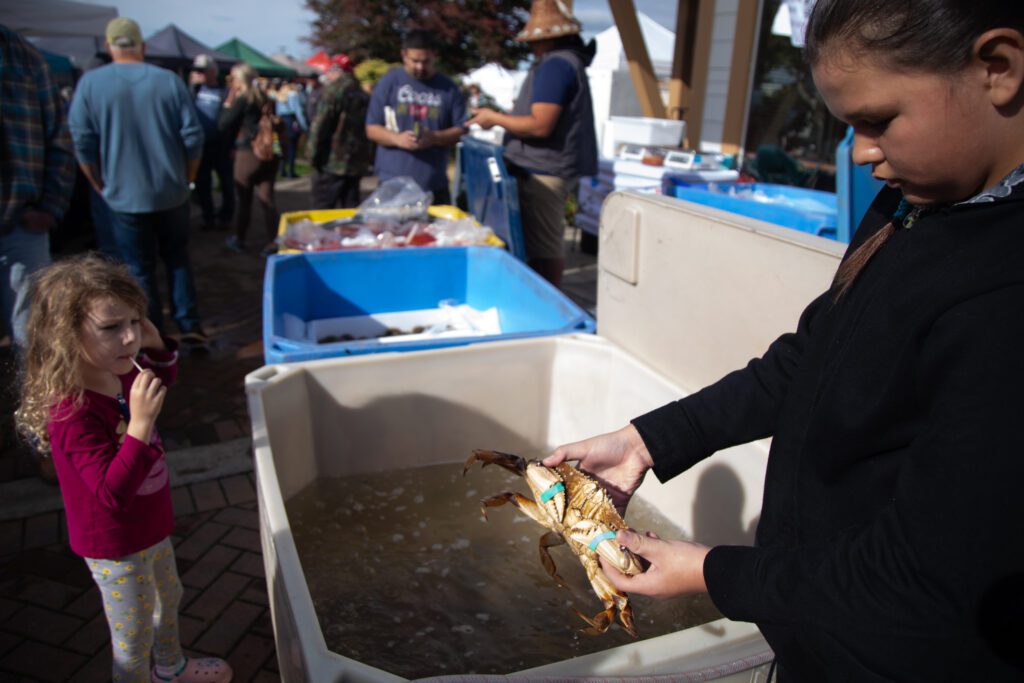
Fishermen still dock their boats and sell fish in Squalicum Harbor, as roller skaters zoom around Zuanich Point Park and sailboats race in regattas beyond the breakwaters.
Along the Whatcom Waterway, a pile of scrap metal amassed by a Canadian firm, ABC Recycling, stands tall, looming over a shipping-container retail village and a pair of condominium complexes as yet-unfinished by developer Harcourt.
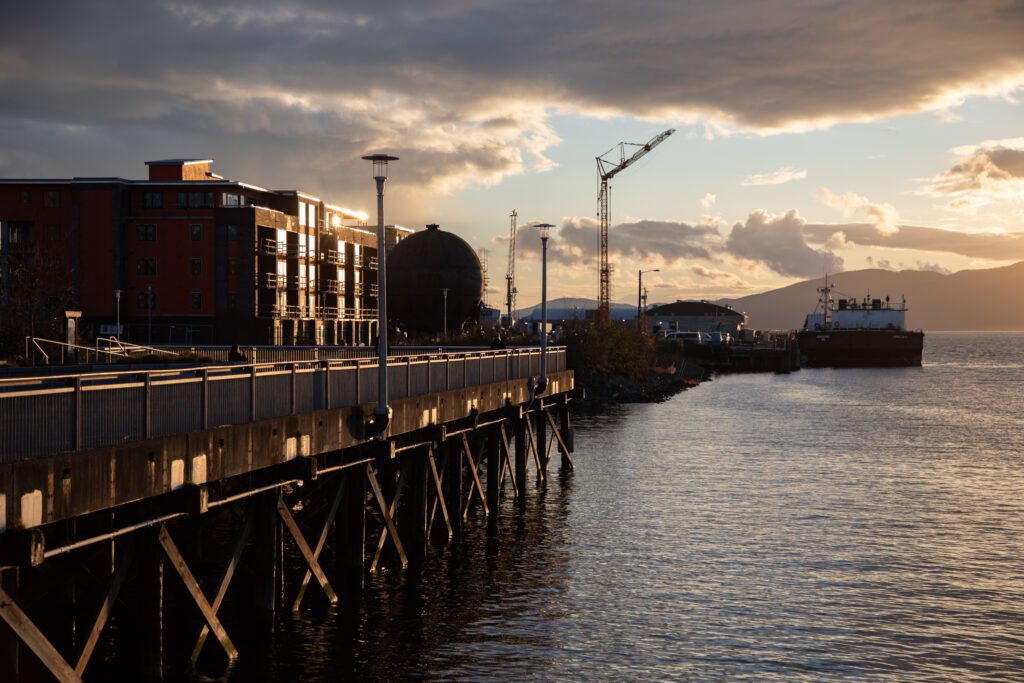
A new shoreline city park, called Waypoint, dotted by “iconic” rusting relics of the old G-P plant, draws curious daily visitors as cyclists whoop over jumps on a popular “temporary” riding track that now feels more permanent.
Compared to its industrial past, the scene is peaceful, but feels unfinished.
Coming in January: A close look at the fishermen, boating businesses and marine industry innovation of the present waterfront — including a 94-year-old historic boat that succeeds thanks to the support of dozens of local economic partners.

